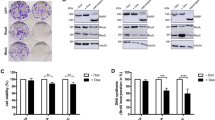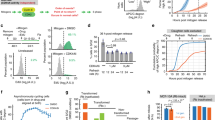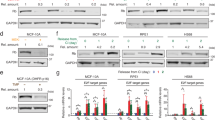Abstract
All-trans retinoic acid inhibits growth associated with downregulation of cyclin D1 and can cause low level apoptosis in estrogen receptor positive breast cancer cell lines. The cyclin D1 gene is amplified and/or the protein overexpressed in about one-third of breast cancers. Constitutive expression of cyclin D1 in estrogen receptor positive MCF-7 and ZR-75 breast cancer cells (MCF-7(cycD1) and ZR-75(cycD1)) Increased the fraction of cells in S phase and reduced the G1 accumulation following retinoic acid treatment compared with control cells. However, culture of MCF-7(cycD1) with 1 μM all-trans retinoic acid resulted in about threefold greater growth inhibition compared with vector-transfected cells. Hoechst staining of DNA and in situ DNA end-labeling analysis indicated that MCF-7(cycD1) and ZR-75(cycD1) cultures contained 4–6-fold more retinoic acid-induced apoptotic nuclei as vector-transfected cells. Retinoic acid treatment of vector-transfected clones resulted in Bax protein activation as assessed by exposure of the NH2-terminus of Bax but the proportion of cells containing activated Bax was increased in cyclin D-expressing cells treated with retinoic acid. The latter cells also displayed both immunocytochemical and biochemical evidence of translocation of cytochrome c into the cytosol following RA-treatment. Retinoic acid markedly decreased the Bcl-2 levels in MCF-7 and ZR-75 cells. Accordingly, coexpression of Bcl-2 and cyclin D1 rendered the cells resistant to retinoic acid-induced apoptosis. We conclude that constitutive expression of cyclin D1 sensitizes ER-positive breast cancer cells to a retinoic acid-induced mitochondrial death pathway involving Bax activation, cytochrome c release and caspase-9 cleavage.
This is a preview of subscription content, access via your institution
Access options
Subscribe to this journal
Receive 50 print issues and online access
$259.00 per year
only $5.18 per issue
Buy this article
- Purchase on Springer Link
- Instant access to full article PDF
Prices may be subject to local taxes which are calculated during checkout









Similar content being viewed by others
References
Adams JM, Cory S . 1998 Science 281: 1322–1326
Ashkenazi A, Dixit VM . 1999 Curr. Opin. Cell Biol. 11: 255–260
Bardon S, Razanamahefa L . 1998 Int. J. Oncol. 12: 355–359
Chao DT, Korsmeyer SJ . 1998 Annu. Rev. Immunol. 16: 395–419
Chen H, Lin RJ, Schiltz RL, Chakravarti D, Nash A, Nagy L, Privalsky ML, Nakatani Y, Evans RM . 1997 Cell 90: 569–578
Chen C, Okayama H . 1987 Mol. Cell. Biol. 7: 2745–2752
Desagher S, Osen-Sand A, Nichols A, Eskes R, Montessuit S, Lauper S, Maundrell K, Antonsson B, Martinou JC . 1999 J. Cell Biol. 144: 891–901
Eck KM, Yuan L, Duffy L, Ram PT, Ayettey S, Chen I, Cohn CS, Ree-Hill SM . 1998 Br. J. Cancer 77: 2129–2137
Elstener E, Muller C, Koshizuka K, Williamson EA, Park D, Asou H, Shintaku P, Said JW, Heber D, Koeffler HP . 1998 Proc. Natl. Acad. Sci. USA 95: 8806–8811
Evan GI, Wyllie AG, Gilbert CS, Littlewood TD, Land H, Brooks M, Waters CM, Penn LZ, Hancock DC . 1992 Cell 69: 119–128
Fliss H, Gattinger D . 1996 Circ. Res. 79: 949–956
Gianni M, Ponzanelli I, Mologni L, Reichert U, Rambaldi A, Terao M, Garattini E . 2000 Cell Death Differ. 7: 447–460
Glass CK, Rosenfeld MG, Rose DW, Kurokawa R, Kamei Y, Xu L, Torchia J, Ogliastro M-H, Westin S . 1997 Biochem. Soc. Trans. 25: 602–605
Green A, Shilkaitis A, Christov K . 1999 Carcinogenesis 20: 1535–1540
Gross A, McDonnell JM, Korsmeyer SJ . 1999 Genes Dev. 18: 1899–1911
Gudas LJ . 1992 Cell Growth Differ. 3: 655–662
Hakem A, Sasaki T, Kozieradzki I, Penninger JM . 1999 J. Exp. Med. 189: 957–968
Hsu YT, Wolter KG, Youle RJ . 1997 Proc. Natl. Acad. Sci. USA 94: 3668–3672
Hsu YT, Youle RJ . 1997 J. Biol. Chem. 272: 13829–13834
Juin P, Hueber AO, Littlewood T, Evan G . 1999 Genes Dev. 13: 1367–1381
Kastner P, Mark M, Chambon P . 1995 Cell 8: 859–869
Kelekar A, Thompson CB . 1998 Trends Cell Biol. 8: 324–330
Korzus E, Torchia J, Rose DW, Xu L, Kurokawa R, McInerney EM, Mullen TM, Glass CK, Rosenfeld MG . 1998 Science 279: 703–707
Krajewski S, Krajewska M, Ellerby LM, Welsh K, Xie Z, Deveraux QL, Salvesen GS, Bresden DE, Rosenthal RE, Fiskum G, Reed JC . 1999 Proc. Natl. Acad. Sci. USA 96: 5752–5757
Kurokawa R, Kalafus D, Ogliastro MH, Kioussi C, Xu L, Torchia J, Rosenfeld M, Glass CK . 1998 Science 279: 700–703
Lammie GA, Fantl V, Smith R, Schuuring E, Brookes S, Michlides R, Dickson C, Arnold A, Peters G . 1991 Oncogene 6: 439–444
Li H, Zhu H, Xu CJ, Yuan J . 1998 Cell 94: 491–501
Li P, Nijhawan D, Budihardjo I, Srinivasula SM, Ahmad M, Alnemri ES, Wang X . 1997 Cell 91: 479–489
Lippman ME . 1985 Endocrine responsive cancers of man. In Williams RH (ed). Textbook of Endocrinology W. B. Saunder Co.: Philadelphia pp. 1309–1326
Lippman SM, Lotan R . 2000 J. Nutr. 130: 479S–482S
Liu Y, Lee MO, Wang HG, Li Y, Hashimoto Y, Klaus M, Reed JC, Zhang XK . 1996 Mol. Cell. biol. 16: 1138–1149
Mangiarotti R, Danova M, Alberici R, Pillicciari C . 1998 Br. J. Cancer 77: 186–191
Manna SK, Aggarwal BB . 2000 Oncogene 10: 2110–2119
Meier CA . 1997 J. Recept. Signal Transduct. Res. 17: 319–335
Moon RC, Mehta RG, Detrisac CJ . 1992 Cancer Detec. Prev. 16: 73–79
Murphy KM, Streips UN, Lock RB . 2000 J. Biol. Chem. 275: 17225–17228
Nagy L, Thomazy VA, Heyman RA, Davies PJ . 1998 Cell Death Differ. 5: 11–19
Oh Y, Gueev Z, Ng L, Muller HL, Rosenfeld RG . 1995 Prog. Growth Factor Res. 6: 503–512
Oswald F, Lovec H, Moroy T, Lipp M . 1994 Oncogene 9: 2029–2036
Qin XQ, Livingston DM, Kaelin WG, Adams PD . 1994 Proc. Natl. Acad. Sci. USA 91: 10918–10922
Raffo P, Emionite L, Colucci L, Belmondo F, Moro MG, Bollag W, Toma S . 2000 Anticancer Res. 20: 1535–1543
Rao L, Debbas M, Sabbatini P, Hockenbery D, Korsmeyer S, White E . 1992 Proc. Natl. Acad. Sci. USA 89: 7742–7746
Reed JC . 1998 Oncogene 17: 3225–3236
Roman SD, Clarke CL, Hall RE, Alexander IE, Sutherland RL . 1992 Cancer Res. 52: 2236–2242
Salo S, Hanada M, Bodurug S, Irie S, Iwama N, Boise LH, Thompson CB, Golemis E, Fong L, Wang HG, Reed JC . 1994 Proc. Natl. Acad. Sci. USA 91: 923–932
Schmidt EV . 1996 BioEssays 18: 6–8
Sedlak TW, Oltvai ZN, Yang E, Wang K, Boise LH, Thompson CB, Korsmeyer SJ . 1995 Proc. Natl. Acad. Sci. USA 92: 7834–7838
Seewaldt VL, Kim JH, Caldwell LE, Johnson BS, Swisshelm K, Collins SJ . 1997 Cell Growth Differ. 8: 631–641
Seewaldt VL, Kim JH, Parker MB, Dietze EC, Srinivasan KV, Caldwell LE . 1999 Exp. Cell Res. 249: 70–85
Seewaldt VL, Johnson BS, Parker MB, Collins SJ, Swisshelm K . 1995 Cell Growth Differ. 6: 1077–1088
Sgambato A, Han EK, Zhang YJ, Moon RC, Santella RM, Weinstein I . 1995 Carcinogenesis 16: 2193–2198
Shang Y, Baumrucker CR, Green MH . 1999 J. Biol. Chem. 274: 18005–18010
Shi L, Nishuika WK, Th’ng J, Bradbury EM, Litchfield DW, Greenberg AH . 1994 Science 263: 1143–1145
Slee E, Harte MT, Kluck RM, Wolf BB, Casiano CA, Newmeyer DD, Wang H-G, Reed JC, Nicholson DW, Alnemri ES, Green DR, Martin SJ . 1999 J. Cell Biol. 144: 281–292
Sofer-Levi Y, Resnitzky D . 1996 Oncogene 13: 2431–2437
Spencer TE, Jenster G, Burcin MM, Allis CD, Zhou J, Mizzen C, McKenna NJ, Onate SA, Tsai SY, Tsai M-J, O'Malley B . 1997 Nature 389: 194–198
Spinella MJ, Freemantle SJ, Sekula D, Chang JH, Christie AJ, Dmitrovsky E . 1999 J. Biol. Chem. 274: 22013–22018
Sukumar S, McKenzie K, Chen Y . 1995 Mutat. Res. 333: 37–44
Teixeira C, Pratt MAC . 1997 Mol. Endocrinol. 11: 1191–1202
Vander Burg B. van der Leede B-JM. Kwakkenbos-Isbrucker L, Salverda S, de Kaat SW, van der Saag PT . 1992 Mol. Cell. Endocrinol. 91: 149–157
Wang Q, Yang W, Uytingco MS, Christakos S, Wieder R . 2000 Cancer Res. 60: 2040–2048
Zhang D, Holmes WF, Wu S, Soprano DR, Soprano KJ . 2000 J. Cell. Physiol. 185: 1–20
Zhou Q, Stetler-Stevenson M, Steeg PS . 1997 Oncogene 15: 107–115
Zwijsen RML, Klompmaker R, Wientjens EBHGM, Kristel PMP, Van Der Burg B, Michalides RJAM . 1996 Mol. Cell. Biol. 16: 2554–2560
Acknowledgements
Supported by grants 98-B062 from the American Institute for Cancer Research to MAC Pratt and NIH-Gm60554 to JC Reed.
Author information
Authors and Affiliations
Rights and permissions
About this article
Cite this article
Niu, MY., Ménard, M., Reed, J. et al. Ectopic expression of cyclin D1 amplifies a retinoic acid-induced mitochondrial death pathway in breast cancer cells. Oncogene 20, 3506–3518 (2001). https://doi.org/10.1038/sj.onc.1204453
Received:
Revised:
Accepted:
Published:
Issue Date:
DOI: https://doi.org/10.1038/sj.onc.1204453
Keywords
This article is cited by
-
RARβ2 hypermethylation is associated with poor recurrence-free survival in never-smokers with adenocarcinoma of the lung
Clinical Epigenetics (2015)
-
Silencing CDK4 radiosensitizes breast cancer cells by promoting apoptosis
Cell Division (2013)
-
Cyclin D1 mediates resistance to apoptosis through upregulation of molecular chaperones and consequent redistribution of cell death regulators
Oncogene (2008)
-
Novel retinoic acid metabolism blocking agents have potent inhibitory activities on human breast cancer cells and tumour growth
British Journal of Cancer (2007)
-
Regulation of survivin by retinoic acid and its role in paclitaxel-mediated cytotoxicity in MCF-7 breast cancer cells
Apoptosis (2006)



